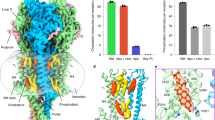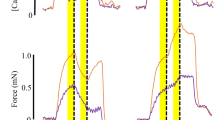Abstract
THERE is evidence for1–3 and against4,5 the involvement of cyclic nucleotides in the release of neurotransmitters. We have investigated this question using a method more suited to the detection of prejunctional drug actions than those used previously. Instead of trying to infer the action of nucleotides on nerve endings by recording endplate potentials or muscle contractions in vitro, we recorded from single motor axons of cat soleus nerves in vivo. We found that dibutryl (db) cyclic AMP initiated activity in unstimulated motor axons and produced stimulus-bound AMP, db cyclic GMP, sodium butyrate and 5′ AMP had no repetitive activity (SBR) in stimulated axons, whereas cyclic effect. NaF and theophylline also initiated activity in unstimulated axons and produced SBR in stimulated axons. Pretreatment with the theophylline potentiated the effects of db cyclic AMP or NaF. The results suggest that cyclic AMP is involved in the excitation–secretion sequence of mammalian motor nerve endings.
This is a preview of subscription content, access via your institution
Access options
Subscribe to this journal
Receive 51 print issues and online access
$199.00 per year
only $3.90 per issue
Buy this article
- Purchase on Springer Link
- Instant access to full article PDF
Prices may be subject to local taxes which are calculated during checkout
Similar content being viewed by others
References
Goldberg, A. L., and Singer, J. J., Proc. natn. Acad. Sci. U.S.A. . 64, 134–141 (1969).
Breckenridge, B. M., Burn, J. H., and Matschinsky, F. H., Proc. natn. Acad. Sci. U.S.A., 57, 1893–1897 (1967).
Wilson, D. F., J. Pharmac. exp. Ther., 188, 447–451 (1974).
Miyamoto, M. D., and Breckenridge, B. M., J. gen. Physiol., 63, 609–624 (1974).
Ginsborg, B. L., and Hirst, G. D., J. Physiol., Lond., 224, 629–645 (1972).
Riker, W. F., Roberts, J., Standaert, F. G., and Fugimori, H. J., J. Pharmac., 211, 286–312 (1957).
Sheppard, H., and Burghardt, C. R., Biochem. Pharmac., 22, 427–429 (1973).
Standaert, F. G., and Riker, W. F., Ann. N. Y. Acad. Sci., 144, 517–533 (1967).
Hubbard, J. I., in Studies in Physiology, 85–92 (Springer, Berlin, 1965).
Sutherland, E. W., and Oye, I., Rec. Prog. Hormone Res., 21, 623–646 (1965).
Rasmussen, H., Science, 170, 404–412 (1970).
Ame, M. S., and McKinney, G. R., Cyclic Nucleotides and Drug Discovery, 203–212 (1975).
Rasmussen, H., and Tenenhouse, A., Proc. natn. Acad. Sci. U.S.A., 59, 1364–1370 (1968).
Greengard, P., and Kebabian, J. W., Fedn Proc., 33, 1059–1066 (1974).
Hubbard, J. I., Physiol. Rev., 53, 674–723 (1973).
Author information
Authors and Affiliations
Rights and permissions
About this article
Cite this article
DRETCHEN, K., STANDAERT, F., SKIRBOLL, L. et al. Evidence for a prejunctional role of cyclic nucleotides in neuromuscular transmission. Nature 264, 79–81 (1976). https://doi.org/10.1038/264079a0
Received:
Accepted:
Issue Date:
DOI: https://doi.org/10.1038/264079a0
This article is cited by
-
Resistance to pancuronium in an asthmatic patient treated with aminophylline and steroids
Canadian Anaesthetists’ Society Journal (1982)
-
Possible role of cyclic nucleotides in regulation of noradrenaline release from rat pineal through presynaptic adrenoceptors
Nature (1978)
-
Evidence for a cyclic nucleotide-mediated calcium flux in motor nerve terminals
Nature (1977)
Comments
By submitting a comment you agree to abide by our Terms and Community Guidelines. If you find something abusive or that does not comply with our terms or guidelines please flag it as inappropriate.



